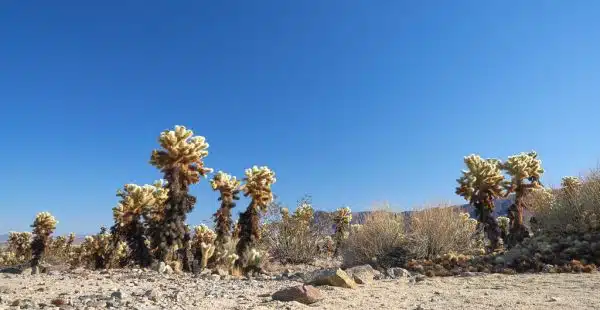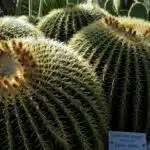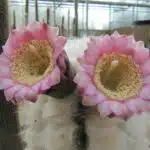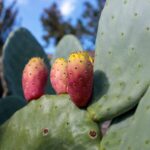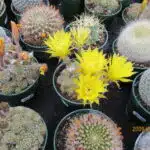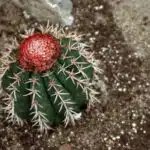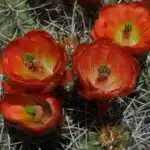Cylindropuntia, also known as cholla cactus, is a popular plant that is widely grown and admired for its unique appearance and low-maintenance requirements. The plant is native to the southwestern United States and Mexico and can be found in a wide range of habitats, including deserts, grasslands, and rocky slopes.
If you are looking for a stunning addition to your garden, cholla cactus might be the perfect choice. In this article, we will discuss everything you need to know about growing and caring for this fascinating plant. From selecting the right soil mix to watering and fertilizing techniques, we will provide you with a comprehensive guide that will help you keep your cholla cactus healthy and thriving. So whether you are an experienced gardener or just starting out, join us on this journey to learn how to grow and care for cholla cactus!
Introducing The Cholla Cactus: A Unique And Low-Maintenance Plant
The Cholla cactus, also known as Cylindropuntia, is a unique and low-maintenance plant that belongs to the Cactaceae family. This plant boasts over 20 different species, each with unique shapes and sizes. Interestingly, the Cholla cactus is known to have originated from the Americas, where it has been used for medicinal and food purposes for many years.
One of the benefits of having a Cholla cactus is that it requires minimal care. These plants thrive in arid environments and can withstand prolonged periods of heat and drought. Additionally, their unique appearance adds character to any garden or indoor space. The Cholla cactus can grow up to 15 feet tall in some species and can produce beautiful flowers ranging from pink to yellow colors.
There are several unique varieties of Cholla cacti available in nurseries today, including pencil chollas, teddy bear chollas, buckhorn chollas, and more. Each variety has its own distinct features that make it stand out from other cacti species. Understanding the basics of Cholla cactus care is essential for ensuring your plant grows healthy and produces beautiful flowers year-round.
Understanding The Basics Of Cholla Cactus Care
After introducing the unique and low-maintenance cholla cactus, it is important to understand the basics of caring for this plant. One key aspect of cholla cactus care is understanding propagation. Cholla cacti can be propagated through cuttings or seeds, but cuttings are the most common method. To propagate through cuttings, choose a healthy segment from your cholla cactus and let it dry for a few days before planting it in well-draining soil.
Another important aspect of cholla cactus care is managing pests. While cholla cacti are generally hardy plants, they can still fall victim to pests like spider mites and mealybugs. If you notice any signs of infestation, such as webbing or white fuzz on your plant’s stems, act quickly to prevent further damage. You can use insecticidal soap or neem oil to get rid of these pests.
In addition to propagation and pest management, choosing the right soil mix for your cholla cactus is crucial. These plants require well-draining soil that won’t retain moisture. A good soil mix for cholla cacti should include sand, perlite, and peat moss in equal parts. Avoid using regular potting soil, which can hold too much water and lead to root rot. With proper propagation techniques, pest management practices, and a suitable soil mix in place, your cholla cactus should thrive with minimal effort on your part.
Choosing The Right Soil Mix For Your Cholla Cactus
When it comes to the best potting mix for your cholla cactus, there are a few things you need to consider. First, it is important to understand that cholla cacti grow in sandy or rocky soil in their natural habitat. Therefore, a well-draining soil mix with a high sand content is ideal for your potted cholla cactus.
The best potting mix for your cholla cactus should be composed of 50% coarse sand and 50% commercial cactus soil. This combination will provide adequate drainage while retaining enough moisture for the plant to thrive. Additionally, adding perlite or vermiculite can also help improve drainage and prevent root rot.
If you don’t have access to commercial cactus soil, there are alternatives that can work just as well. A mixture of regular potting soil and sand can be used as a substitute, but it is important to ensure that the potting soil doesn’t contain any additives like fertilizers or pesticides. Alternatively, you can make your own mix by combining equal parts of sand, peat moss, and perlite.
Choosing the right soil mix is crucial for the optimal growth of your cholla cactus. By providing appropriate growing conditions through the use of a well-draining potting mix, you can ensure that your plant thrives in its new environment. In the next section, we will discuss watering techniques that will help keep your cholla cactus happy and healthy.
Watering Techniques For Optimal Growth
Watering frequency is one of the most important factors in growing and caring for cholla cactus. These plants are native to arid regions, which means that they are adapted to survive on very little water. Overwatering can lead to root rot and other problems, so it’s important to get the watering frequency right. In general, you should only water your cholla cactus when the soil is completely dry.
When it comes to watering techniques, there are a few things to keep in mind. First, always use a pot with good drainage holes. This will prevent water from pooling in the bottom of the pot and causing root rot. Second, water your cholla cactus from below rather than above. This will help prevent damage to the plant’s spines and prevent moisture from sitting on top of the plant where it can cause problems.
In order to determine how often you should water your cholla cactus, you’ll need to pay attention to its specific needs. Factors like temperature, humidity, and sunlight can all impact how quickly soil dries out. Be sure to monitor your plant carefully and adjust your watering schedule as needed. With proper watering techniques and frequency, your cholla cactus will thrive and grow into a beautiful addition to any garden or home décor.
As we have discussed earlier that watering is an essential factor for optimal growth of Cholla Cactus but fertilizing is also an important aspect of its care regimen that cannot be overlooked. Fertilizer provides essential nutrients that help maintain healthy growth in plants by promoting leaf production and overall healthiness of roots; however, over-fertilization can lead to stunted growth or even death of the plant itself. Let us discuss some dos and don’ts while fertilizing these desert plants in our next section.
Fertilizing Your Cholla Cactus: Dos And Don’ts
Watering your cholla cactus properly is crucial for its optimal growth. But watering alone won’t ensure the health of your plant in the long run. Fertilizer application is also necessary to provide your cholla cactus with essential nutrients that it cannot get from water and sunlight alone.
Fertilizer application should be done during the growing season, which is from spring to fall. During this time, your cholla cactus will require more nutrients to support its growth and development. The amount and frequency of fertilizer application will depend on several factors such as the age of the plant, soil quality, and environmental conditions.
However, it’s important to note that excessive fertilizer can cause nutrient deficiencies in your cholla cactus. Over-fertilization can lead to an imbalance in nutrients, which can result in stunted growth or even death of the plant. Therefore, it’s crucial to follow recommended guidelines for fertilizer application and avoid using too much or too little. A balanced fertilizer with an equal ratio of nitrogen, phosphorus, and potassium is ideal for cholla cactus care.
Fertilizing Your Cholla Cactus: Dos and Don’ts
- Do use a balanced fertilizer with equal amounts of nitrogen, phosphorus, and potassium.
- Do fertilize during the growing season (spring to fall).
- Sub-list 1: For young plants:
- Use a half-strength fertilizer solution every two weeks.
- Increase frequency as the plant grows.
- Sub-list 2: For mature plants:
- Use a full-strength solution once a month during the growing season.
- Don’t over-fertilize as this can cause nutrient deficiencies.
- Sub-list 1: Signs of nutrient deficiencies:
- Yellowing or browning of leaves
- Stunted growth
- Leaf drop
- Sub-list 2: To correct nutrient deficiencies:
- Adjust fertilizer application based on the specific nutrient deficiency.
- Use a specialized fertilizer if necessary.
To ensure the optimal growth and health of your cholla cactus, proper fertilization is important. By following recommended guidelines for fertilizer application and avoiding common mistakes such as over-fertilizing, you can provide your plant with the essential nutrients it needs to thrive. In the next section, we’ll discuss how to manage pests and diseases in cholla cactus to further protect its health.
Managing Pests And Diseases In Cholla Cactus
Preventing pests and diseases in cholla cactus is essential for maintaining a healthy plant. One of the most common pests that infest cholla cactus is spider mites. These tiny creatures can cause significant damage to your plant by sucking the sap from the leaves and stems, which eventually leads to yellowing and wilting. To prevent spider mites from infesting your cholla cactus, you should consider keeping the humidity level low around your plant. You can also regularly spray your plant with water to keep it clean and free of dust.
Another pest that can infest your cholla cactus is scale insects. These small insects look like tiny bumps on the leaves or branches of your plant, and they feed on its sap, causing stunted growth and yellowing of leaves. To control scale insects, you should consider using organic remedies such as neem oil or insecticidal soap. You can also prune off infected parts of the plant to prevent further spread.
In addition to pests, diseases such as bacterial soft rot or fungal infections can also affect your cholla cactus. Preventative measures such as ensuring proper drainage and avoiding overwatering can help prevent these diseases. However, if you notice any signs of disease, it’s important to act quickly by removing infected parts of the plant and treating it with organic remedies such as copper fungicides or baking soda solutions.
Moving forward, propagating cholla cactus requires careful attention to detail and specific techniques that vary depending on the species. In the next section, we’ll explore some tips and tricks for successfully propagating cholla cactus at home.
Propagating Cholla Cactus: Tips And Tricks
When it comes to propagating cholla cactus, there are a few tips and tricks that can help increase your chances of success. One of the most effective propagation methods is by taking stem cuttings. To do this, use a clean and sharp pair of pruning shears to cut off a healthy stem from the parent plant. Be sure to choose a stem that is not too young or too old, as these may not root properly.
Before planting the cutting, it is recommended to apply rooting hormones to stimulate root growth. There are several types of rooting hormones available on the market, such as powder or liquid form. These can be found at any garden center or online plant store. Once applied, allow the hormone to dry for a few hours before planting.
When planting your cutting, use a well-draining soil mix and make sure the pot has drainage holes. Water thoroughly after planting and keep the soil moist but not waterlogged. Place the pot in an area with bright but indirect light and avoid direct sunlight until roots have established.
As your cholla cactus grows, it may require pruning and shaping to maintain its shape and size. In the next section, we will discuss some important tips on how to properly prune and shape your cholla cactus without damaging it.
Pruning And Shaping Your Cholla Cactus
Pruning techniques are essential when it comes to caring for your cholla cactus. It is important to prune your cactus regularly to prevent overgrowth and maintain its shape. However, pruning can be a bit challenging due to the plant’s spines. To avoid injuries, wear gloves and use long-handled pruners when pruning your cholla cactus.
When shaping your cholla cactus, you can get creative with designs to make it more visually appealing. You can create a rounded or cylindrical shape by pruning the top and sides of the plant evenly. Alternatively, you can leave some branches longer than others to give it a more unique look. As you prune your cactus, ensure that you do not remove too many branches at once as this may cause stress and damage the plant.
Pruning and shaping your cholla cactus require patience and attention to detail. Remember that these plants are slow-growing, so take time to assess the plant’s growth before making any cuts. By following proper pruning techniques and getting creative with designs, you can keep your cholla cactus healthy and beautiful for years to come.
Overwintering Your Cholla Cactus: Precautions To Take
After successfully pruning and shaping your cholla cactus, it is essential to take precautions for overwintering. During winter storage, the temperature control of your cholla cactus plays a vital role in its survival. It is crucial to keep your cactus in a cool and dry place during the winter months.
To ensure that your cholla cactus survives the winter, follow these three sub-lists:
- Protect from frost: Cholla cacti are not frost-tolerant, and exposure to cold temperatures can cause severe damage or even death. To protect them from frost, bring them indoors before the first frost hits.
- Maintain optimal humidity: While it’s important to keep your cholla cactus in a dry place during winter storage, you don’t want it to become too dry. Use a humidifier or place a tray of water near the plant to maintain optimal humidity levels.
- Avoid overwatering: Overwatering can lead to root rot and other fungal diseases. Check the soil’s moisture level regularly and only water when it’s completely dry.
By following these guidelines, you can help ensure that your cholla cactus stays healthy throughout the winter months.
In summary, proper winter storage with temperature control is essential for maintaining healthy cholla cacti. Remember to protect them from frost, maintain optimal humidity levels, and avoid overwatering. By taking these precautions, you can set yourself up for success come springtime when you bring your beautiful cholla cacti back out into the sun. Next up, we will discuss troubleshooting common issues that may arise when caring for your cholla cactus plants.
Troubleshooting Common Cholla Cactus Issues
Common cholla cactus problems can arise when the plant is not given enough water or when it is exposed to extreme temperatures. One of the most common issues is dehydration, which can cause the cactus to wilt and lose its shape. To solve this problem, you should water your cholla cactus regularly and ensure that the soil remains moist but not waterlogged. If you notice that your cactus is starting to shrivel up, increase watering frequency until it returns to normal.
Another common issue with cholla cacti is sunburn, which occurs when they are placed in direct sunlight for extended periods of time. This can cause discoloration, scarring, and even death if left unchecked. To prevent sunburn, move your cholla cactus to a location where it receives partial shade during the hottest parts of the day. You may also want to consider using a shade cloth or other form of protection during particularly sunny days.
Pests and diseases can also be problematic for cholla cacti. Common pests include spider mites and mealybugs, which can cause damage by feeding on the plant’s sap. Diseases such as root rot can be caused by overwatering or poor drainage and can quickly kill off an entire plant if left untreated. To combat these issues, inspect your plant regularly for any signs of pests or disease and treat them promptly with appropriate insecticides or fungicides as needed.
By following these troubleshooting tips for common cholla cactus problems, you can ensure that your plants remain healthy and thriving for years to come. With proper care and attention, these beautiful desert plants will reward you with their unique beauty and resilience in even the toughest conditions.
Conclusion
The Cholla Cactus, also known as Cylindropuntia, is a fascinating plant that can add a unique touch to any garden or indoor space. As a low-maintenance plant, it is perfect for those who want to enjoy the beauty of nature without too much hassle. To ensure your Cholla Cactus thrives, it’s important to understand the basics of care, including soil mix and watering techniques. Proper fertilization and propagation methods can also help maintain optimal growth.
Pruning and shaping are crucial aspects of caring for your Cholla Cactus, as they help prevent overcrowding and promote healthy growth. Overwintering precautions should also be taken to ensure the plant survives harsh weather conditions. If you encounter common issues such as pests or disease, addressing them early on can prevent further damage.
In conclusion, the Cholla Cactus is a unique and low-maintenance plant that can add character to any space. By understanding its basic care needs, you can ensure optimal growth and longevity. With proper watering techniques, soil mix choices and pruning practices, your Cholla Cactus will thrive for years to come. Remember that with attention to detail and some patience, your Cholla Cactus will become an eye-catching addition to your collection of plants.
Image Credits
- “Cholla Cactus” by szeke (featured)

